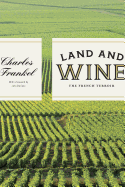
France is justifiably famous for its wines, and in Land and Wine Charles Frankel takes the reader on a geological journey to discover why the French landscape is perfect for growing grapes. Frankel focuses on the terroir--a word without an exact English translation that means the combination of geography, geology and microclimate of a specific small region. Terroir can change rapidly; even grapes grown a few dozen yards apart can produce very different wines.
Frankel explores the wine-making regions of France in order of geological age, starting with Savennières, which sits atop an ancient Hercynian massif in Brittany, and ending with the Rhône Valley. Much of the information is technical, offering detailed descriptions of the soil and rock in each terroir, but the academic tone of these sections is spiked with interesting information about the history of wine making and famous wine-lovers.
For example, on the hill of Corton in Burgundy, 25 wines are produced in an area one-third the size of Central Park. Frankel explains why Corton's terroir has made it ideal for producing so many superior wines--favored by luminaries such as Voltaire and John F. Kennedy--despite being such a tiny area.
Part geology textbook, part history of France, part wine-tasting guide, Land and Wine, while perhaps a bit esoteric for the average layman, is nevertheless fascinating. Wine experts and geologists will both profit from the intriguing information it contains. --Jessica Howard, blogger at Quirky Bookworm

